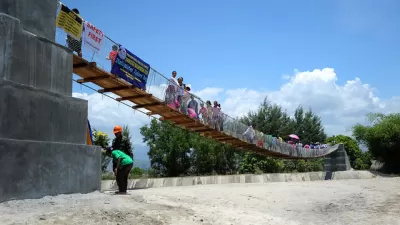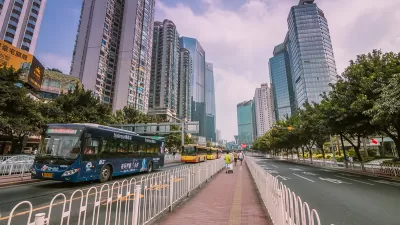Here at Planetizen and Urban Insight, many of our efforts to serve the planning community take place on Windows and Mac computers that would, much like your own computers at your home and office (or even your sparkly new iPhone), dwarf even the most powerful machines of a generation ago. We use these computers to build websites, create maps, share data, explore 3D environments, design, organize databases, and lots of other tasks that can bring new worlds to life without shoveling an ounce of dirt.
 Here at Planetizen and Urban Insight, many of our efforts to serve the planning community take place on Windows and Mac computers that would, much like your own computers at your home and office (or even your sparkly new iPhone), dwarf even the most powerful machines of a generation ago. We use these computers to build websites, create maps, share data, explore 3D environments, design, organize databases, and lots of other tasks that can bring new worlds to life without shoveling an ounce of dirt.
Here at Planetizen and Urban Insight, many of our efforts to serve the planning community take place on Windows and Mac computers that would, much like your own computers at your home and office (or even your sparkly new iPhone), dwarf even the most powerful machines of a generation ago. We use these computers to build websites, create maps, share data, explore 3D environments, design, organize databases, and lots of other tasks that can bring new worlds to life without shoveling an ounce of dirt.
Yet, there are still entire communities in America, and countries throughout the world, that don't collectively have the computing power of an average office in the United States. The nonprofit One Laptop Per Child (OLPC) project is trying to change that. And, in the process, it may change how the world views urban planning.
Early Monday morning OLPC launched its Give One, Get One offer. I was one of those West-Coasters who got up at 3 a.m. PST to purchase two XO laptops – one that will be sent to empower a child to learn in a developing nation, and one that will be sent to my own home for my children. The project is sometimes popularly called the $100 laptop project, since the innovative "One Laptop Per Child" effort, led by MIT's Nicholas Negroponte, seeks to build a unique laptop computer with features for children of the emerging world at an eventual price point of $100 per laptop. The laptops will be sold to governments, to be distributed through the ministries of education willing to adopt the policy of "one laptop per child."
The XO-1 is designed to be low-cost, small (the LCD screen is only 7.5"), durable, and require very little power to run (2 W of power during normal use, far less than the 10 to 45 W of conventional laptops). The signature bright green computer runs on a version of the Linux operating system that is intended to help young children collaborate. All software installed on the machine is open source and free of cost. The XO-1 (first version) includes a video camera, a microphone, long-range Wi-Fi, a style touch pad, and smaller keyboards designed for young fingers.
 Each XO that is shipped will include a copy of the original SimCity (you can play online for free) -- the blockbuster 1989 game credited with giving rise to the genre of the city-building game and to a wholesale revival of interest in urban planning. The story of SimCity is well known: amid an ocean of early sports, adventure, and strategy games, it emerged as the preeminent "realistic" game, perhaps the only one to legitimately fulfill the promise that video games could be both fun and educational. Not long after its 1989 release, SimCity became a phenomenon, winning more than 24 domestic and international awards.
Each XO that is shipped will include a copy of the original SimCity (you can play online for free) -- the blockbuster 1989 game credited with giving rise to the genre of the city-building game and to a wholesale revival of interest in urban planning. The story of SimCity is well known: amid an ocean of early sports, adventure, and strategy games, it emerged as the preeminent "realistic" game, perhaps the only one to legitimately fulfill the promise that video games could be both fun and educational. Not long after its 1989 release, SimCity became a phenomenon, winning more than 24 domestic and international awards.
SimCity gave players the chance not only to manipulate bits of code or finally write that manuscript, but rather to give solidity to their dreams and a semblance, if only virtual, of control over and interest in the world around them. The game soon made its way into more than 10,000 classrooms as an educational tool and became part of the annual Future\City Competition, a contest that still runs in seventh and eighth grade classrooms today. This is the exciting prospect that the recipients of the XO now face.
The idea to connect SimCity with OLPC came from internet pioneer, activist and OLPC advisor, John Gilmore, who knew the game's history and recognized its relevance to the not-for-profit project. Gilmore convinced Electronic Arts to donate the game because he realized what planners already know: As much as we may enjoy pulverizing zombies and calling plays on 4th and inches, cities too are inherently fun. They're fun because they're complex, inscrutable, and, above all else, familiar.
OLPC will begin distributing laptops in countries such as Uruguay, Peru, Mexico, Ethiopia, Rwanda, Haiti, Cambodia and India by the end of 2007. Close to 10 million XO laptops will be shipped by the end of 2008. Some estimate that within five years over 250 million XO laptops will be in the hands of children across the globe. Certainly a computer in the hands of every child will not solve the world's ills, but they will likely be revelatory for those children lucky enough to receive them and to tap into their potential.
You may have shared my experience in encountering plenty of people who don't recognize the term "urban planner", let alone recognize it as a field of study or a possible profession. Doctors, firemen/women, teachers, lawyers, architects -- these are professions that we're introduced to early in life. But Urban Planners? I myself didn't even know about the field until I was midway through my undergraduate degree. What if I had been introduced to it when I was six?
Obviously not every child who receives an XO laptop will become a planner. But the exposure to SimCity has the potential to get a new generation thinking about the places where they live and introducing the mind-expanding concept that a person can design and build a city. Begin to imagine how the field of planning will evolve when 250 million children start noodling around with urban planning on a daily basis.

Alabama: Trump Terminates Settlements for Black Communities Harmed By Raw Sewage
Trump deemed the landmark civil rights agreement “illegal DEI and environmental justice policy.”

Planetizen Federal Action Tracker
A weekly monitor of how Trump’s orders and actions are impacting planners and planning in America.

The 120 Year Old Tiny Home Villages That Sheltered San Francisco’s Earthquake Refugees
More than a century ago, San Francisco mobilized to house thousands of residents displaced by the 1906 earthquake. Could their strategy offer a model for the present?

Ken Jennings Launches Transit Web Series
The Jeopardy champ wants you to ride public transit.

BLM To Rescind Public Lands Rule
The change will downgrade conservation, once again putting federal land at risk for mining and other extractive uses.

Indy Neighborhood Group Builds Temporary Multi-Use Path
Community members, aided in part by funding from the city, repurposed a vehicle lane to create a protected bike and pedestrian path for the summer season.
Urban Design for Planners 1: Software Tools
This six-course series explores essential urban design concepts using open source software and equips planners with the tools they need to participate fully in the urban design process.
Planning for Universal Design
Learn the tools for implementing Universal Design in planning regulations.
Clanton & Associates, Inc.
Jessamine County Fiscal Court
Institute for Housing and Urban Development Studies (IHS)
City of Grandview
Harvard GSD Executive Education
Toledo-Lucas County Plan Commissions
Salt Lake City
NYU Wagner Graduate School of Public Service





























